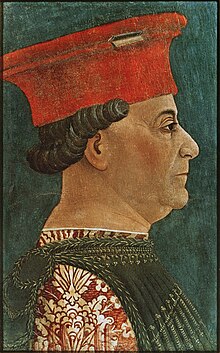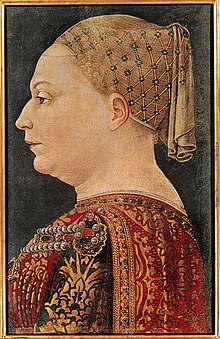Francesco I. Sforza

Sforza insisted on being painted with the old hat he wore as a condottiere .
Francesco Sforza (born July 23, 1401 in San Miniato , † March 6, 1466 in Milan ) was the founder of the Sforza dynasty in Milan.
Life
Francesco was the illegitimate son of Muzio Attendolo Sforza and Lucia of Torsano. After his father's death in 1424 he took over the leadership of his mercenary troops , for which he qualified on the one hand through physical strength (he was famous for bending metal with his bare hands), but later also as an exceptional tactician and commander.
He served the Visconti against Venice and then Venice against the Visconti, attacked the Pope, drove him out of Romagna and later defended him.
Francesco Sforza was his first marriage on October 19, 1418, Polissena Ruffo, daughter of Carlo Ruffo, Count of Montalto . With her he had a daughter who was also called Polissena and died in 1420, the same year the mother also died. In 1441 he married Bianca Maria (around 1424–1468), the only daughter of Filippo Maria Visconti , Duke of Milan . He received Pontremoli and Cremona as a dowry as well as the promise of succession in the duchy. The short-lived Ambrosian Republic , established by the Milanese when Visconti died (1447), was subjugated by Francesco, who triumphantly entered the city as Duke on March 25, 1450. In the Peace of Lodi in 1454 he achieved the recognition of his rule by the Republic of Venice, which the other Italian states soon followed. He suppressed an uprising in Piacenza , allied closely with Cosimo de 'Medici (1389–1464) and Louis XI. of France (ruled 1461–1483) and ruled Lombardy , some areas south of the Po and even Genoa .
He had the Porta Giovio fortress rebuilt, the great hospital and the Martesana Canal, which connects Milan with the Adda ; his court, which he filled with Italian scholars and Greek exiles (as a result of the conquest of Constantinople ), quickly became one of the most distinguished in Italy. His daughter Ippolita was famous for her Latin speeches. Francesco left several sons, including Galeazzo Maria , Ludovico , called "il Moro" ("the dark one" or "the Moor"), and Ascanio Sforza , who became a cardinal .
Francesco is mentioned several times in Machiavelli's "Il principe" ( The Prince ); he is consistently praised for his abilities as regent, but also presented as a warning not to associate with mercenary troops. On behalf of his son Ludovico Sforza, Leonardo da Vinci was busy planning a monumental equestrian statue of Francesco Sforza from around 1489 , but it was never executed.
progeny
With his second wife Bianca Maria Visconti he had the following children:
- Galeazzo Maria Sforza (1444–1476), Duke of Milan 1466
- Ippolita Sforza (April 18, 1446 - August 20, 1484), ⚭ 1465 Alfonso II of Aragon , King of Naples (1448–1495), ( House of Trastámara )
- Filippo Maria Sforza (1448–1492), ⚭ Konstanze Sforza, daughter of Bosio Sforza
- Sforza Maria Sforza (Aug. 18, 1451 - July 29, 1479), Duke of Bari
- Ludovico Sforza , "il Moro" (1451–1508), Duke of Milan (1494–1499)
- Ottaviano Sforza (April 30, 1458 - 1477)
- Elisabetta Sforza († 1473), ⚭ 1469 Wilhelm VIII. Margrave of Montferrat († 1483)
- Ascanio Sforza (1455–1505), 1484 cardinal
literature
- Giuseppe Chiesi: Francesco Sforza. In: Historical Lexicon of Switzerland . August 31, 2011 , accessed December 17, 2019 .
Web links
- Literature by and about Francesco I. Sforza in the catalog of the German National Library
| predecessor | Office | successor |
|---|---|---|
| Ambrosian Republic |
Duke of Milan 1450–1466 |
Galeazzo Maria Sforza |
| personal data | |
|---|---|
| SURNAME | Sforza, Francesco I. |
| ALTERNATIVE NAMES | Sforza, Francesco |
| BRIEF DESCRIPTION | Founder of the Sforza dynasty in Milan |
| DATE OF BIRTH | July 23, 1401 |
| PLACE OF BIRTH | San Miniato |
| DATE OF DEATH | March 6, 1466 |
| Place of death | Milan |

